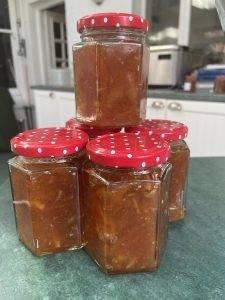January is fast running out and now is the best and, perhaps, the only time to get hold of Seville oranges for marmalade. If you buy lots, they freeze well if you have enough room.
I’ve been developing this recipe over the last couple of years, looking for a result that is as fresh and tangy as possible to do justice to the fruit. The secret is to add the juice last, have good organisation and allow enough time. There are three main steps:
- Juicing and then simmering the oranges.
- Slicing the oranges and making the marmalade.
- Potting up.
I aim to complete the first step one evening, let the oranges cool overnight, make the marmalade next day and wait at least an hour before completing the process.
1.5kg Seville oranges, scrubbed.
4 lemons, scrubbed.
water.
2 kg granulated sugar.
Organisation needs:
Chopping board and knife
Preserving pan and heat-proof plate plus wooden spoon.
Container with lid for juice (I like an ice-cream box to make pouring easier) plus another similar container.
Kitchen scales.
Bowl lined with muslin or other thin fabric for pips plus string or clip for securing
Electric juicer. (The old-fashioned manual version works just as well but takes longer
Cooking thermometer.
Jars with lids.
Roasting tray.
Jam funnel and ladle.
Step 1.
Weigh the two empty containers and make a note of their weight.
Cut the fruit in half and extract the juice, pouring juice into one container, pips into the cloth and fruit halves into the pan.
Weigh the container of juice so you know the weight of the juice, lid the container and store in the fridge.
Enclose the pips in the cloth and tie or clip into a bundle that is then suspended amongst the fruit halves in the preserving pan (making sure to keep any ends of the cloth away from the heat of the hob).
Place the plate on the fruit halves to stop them floating and then add enough water to cover the fruit.
Simmer the fruit until soft (a couple of hours) and then leave to cool (perhaps overnight).
Step 2.
Remove the plate from the pan. Squeeze the bundle of pips to extract any juice and then discard.
Remove each piece of fruit from the pan; scrape out any remaining pith and discard. Slice the fruit as finely as possible, setting aside the strips in the bowl.
Remove the simmering liquid and strain into the spare empty container and weigh.
Wash out the preserving pan and place all the strips of fruit into it.
Calculate the weight of water needed to bring the total weight of liquid (water, simmering liquid and juice) to2kg.
Weigh that amount of water and add to the preserving pan with the simmering liquid.
Bring the pan of fruit pieces and liquid to a gentle simmer before adding the sugar.
Heat gently, stirring, until the sugar has dissolved and then increase the heat to bring the pan contents to about 105-106C, stirring occasionally.
Add the fruit juice and continue heating until the temperature reaches 106-107C, stirring occasionally.
Remove from the heat and allow to cool for 30-60 minutes.
Step 3.
Wash the jars and place in a roasting tray in the oven at the lowest heat for 30-60 minutes to sterilise (and heat up to avoid cracking when the marmalade is poured in).
Remove the roasting tin from the oven and, using the jam funnel, ladle the marmalade into the jars and screw on lids.
Once cool, wash the jars to remove any spills and label.
In broad terms, there will be over 2 kg each of oranges and lemons, water/juice and sugar to produce about 4kg marmalade (this week, I made just over 16 250g jars) They make perfect presents for next Christmas! How’s that for forward planning?
Words:
Standard plus:
Blind cook, Seville oranges, marmalade, Covid cookbook, www.pennymelvillebrown.com

